*NURSING > QUESTIONS & ANSWERS > NSG 6020 FINAL STUDY GUIDE / NSG 6020 FINAL POSSIBLE QUESTIONS. SOUTH UNIVERSITY (100% Correct) (All)
NSG 6020 FINAL STUDY GUIDE / NSG 6020 FINAL POSSIBLE QUESTIONS. SOUTH UNIVERSITY (100% Correct)
Document Content and Description Below
1. Question : You are beginning the examination of the skin on a 25-year-old teacher. You have previously elicited that she came to the office for evaluation of fatigue, weight gain, and hair loss. Yo... u strongly suspect that she has hypothyroidism. What is the expected moisture and texture of the skin of a patient with hypothyroidism? Student Answer: Moist and smooth Moist and rough Dry and smooth Dry and rough Points Received: 1 of 1 Comments: Question 2. Question : You are assessing a patient with joint pain and are trying to decide whether it is inflammatory or noninflammatory in nature. Which one of the following symptoms is consistent with an inflammatory process? Student Answer: Tenderness Cool temperature Ecchymosis Nodules Points Received: 1 of 1 Comments: Question 3. Question : A 68-year-old retired farmer comes to your office for evaluation of a skin lesion. On the right temporal area of the forehead, you see a flattened papule the same color as his skin, covered by a dry scale that is round and feels hard. He has several more of these scattered on the forehead, arms, and legs. Based on this description, what is your most likely diagnosis? Student Answer: Actinic keratosis Seborrheic keratosis Basal cell carcinoma Squamous cell carcinoma Points Received: 0 of 1 Comments: Question 4. Question : A 28-year-old graduate student comes to your clinic for evaluation of pain “all over.” With further questioning, she is able to relate that the pain is worse in the neck, shoulders, hands, low back, and knees. She denies swelling in her joints. She states that the pain is worse in the morning. There is no limitation in her range of motion. On physical examination, she has several points on the muscles of the neck, shoulders, and back that are tender to palpation. Muscle strength and range of motion are normal. Which one of the following is likely the cause of her pain? Student Answer: Rheumatoid arthritis Osteoarthritis Fibromyalgia Polymyalgia rheumatica Points Received: 1 of 1 Comments: Question 5. Question : Heberden’s nodes are commonly found in which one of the following diseases? Student Answer: Rheumatoid arthritis Degenerative joint disease Psoriatic arthritis Septic arthritis Points Received: 1 of 1 Comments: Question 6. Question : A new patient is complaining of severe pruritus that is worse at night. Several family members also have the same symptoms. Upon examination, areas of excoriated papules are noted on some of the interdigital webs of both hands and on the axillae. This finding is most consistent with: Student Answer: Contact dermatitis Impetigo Larva migrans Scabies Points Received: 1 of 1 Comments: Question 7. Question : An obese 55-year-old woman went through menarche at age 16 and menopause 2 years ago. She is concerned because an aunt had severe osteoporosis. Which one of the following is a risk factor for osteoporosis? Student Answer: Obesity Late menopause Having an aunt with osteoporosis Delayed menarche Points Received: 0 of 1 Comments: Question 8. Question : Ms. Whiting is a 68-year-old female who comes in for her usual follow-up visit. You notice a few flat red and purple lesions, about 6 centimeters in diameter, on the ulnar aspect of her forearms but nowhere else. She doesn't mention them. They are tender when you examine them. What should you do? Student Answer: Conclude that these are lesions she has had for a long time. Wait for her to mention them before asking further questions. Ask how she acquired them. Conduct the visit as usual for the patient. Points Received: 1 of 1 Comments: Question 9. Question : A 58-year-old man comes to your office complaining of bilateral back pain that now awakens him at night. This has been steadily increasing for the past 2 months. Which one of the following is the most reassuring in this patient with back pain? Student Answer: Age over 50 Pain at night Pain lasting more than 1 month or not responding to therapy Pain that is bilateral Points Received: 1 of 1 Comments: Question 10. Question : The Phalen’s test is used to evaluate: Student Answer: Inflammation of the median nerve Rheumatoid arthritis Degenerative joint changes Chronic tenosynovitis 1. Question : Which of the following would lead you to suspect a hydrocele versus other causes of scrotal swelling? Student Answer: The presence of bowel sounds in the scrotum Being unable to palpate superior to the mass A positive transillumination test Normal thickness of the skin of the scrotum Comments: Question 2. Question : You are examining a newborn and note that the right testicle is not in the scrotum. What should you do next? Student Answer: Refer to urology Recheck in six months Tell the parent the testicle is absent but that this should not affect fertility Attempt to bring down the testis from the inguinal canal Comments: Question 3. Question : A 50-year-old truck driver comes to your clinic for a work physical. He has had no upper respiratory, cardiac, pulmonary, gastrointestinal, urinary, or musculoskeletal system complaints. His past medical history is significant for mild arthritis and prior knee surgery in college. He is married and just changed jobs, working for a different trucking company. He smokes one pack of cigarettes a day, drinks less than six beers a week, and denies using any illegal drugs. His mother has high blood pressure and arthritis and his father died of lung cancer in his sixties. On examination, his blood pressure is 130/80 and his pulse is 80. His cardiac, lung, and abdominal examinations are normal. He has no inguinal hernia, but on his digital rectal examination you palpate a soft, smooth, and nontender pedunculated mass on the posterior wall of the rectum. What anal, rectal, or prostate disorder best fits his presentation? Student Answer: Internal hemorrhoid Prostate cancer Anorectal cancer Rectal polyp Comments: Question 4. Question : A 15-year-old high school football player is brought to your office by his mother. He is complaining of severe testicular pain since exactly 8:00 this morning. He denies any sexual activity and states that he hurts so bad he can't even urinate. He is nauseated and is throwing up. He denies any recent illness or fever. His past medical history is unremarkable. He denies any tobacco, alcohol, or drug use. His parents are both in good health. On examination, you see a young teenager lying on the bed with an emesis basin. He is very uncomfortable and keeps shifting his position. His blood pressure is 150/100, his pulse is 110, and his respirations are 24. On visualization of the penis, he is circumcised and there are no lesions and no discharge from the meatus. His scrotal skin is tense and red. Palpation of the left testicle causes severe pain and the patient begins to cry. His prostate examination is unremarkable. His cremasteric reflex is absent on the left but is normal on the right. By catheter you get a urine sample and the analysis is unremarkable. You send the boy with his mother to the emergency room for further workup. Student Answer: Acute orchitis Acute epididymitis Torsion of the spermatic cord Prostatitis Comments: Question 5. Question : Which is true of prostate cancer? Student Answer: It is commonly lethal. It is one of the less common forms of cancer. Family history does not appear to be a risk factor. Ethnicity is a risk factor. Comments: Question 6. Question : Which of the following conditions involves a tight prepuce which, once retracted, cannot be returned? Student Answer: Phimosis Paraphimosis Balanitis Balanoposthitis Comments: Question 7. Question : A 12-year-old is brought to your clinic by his father. He was taught in his health class at school to do monthly testicular self-examinations. Yesterday, when he felt his left testicle, it was enlarged and tender. He isn't sure if he has had burning with urination and he says he has never had sexual intercourse. He has had a sore throat, cough, and runny nose for the last three days. His past medical history is significant for a tonsillectomy as a small child. His father has high blood pressure and his mother is healthy. On examination, you see a child in no acute distress. His temperature is 100.8 and his blood pressure and pulse are unremarkable. On visualization of his penis, he is uncircumcised and has no lesions or discharge. His scrotum is red and tense on the left and normal appearing on the right. Palpating his left testicle reveals a mildly sore swollen testicle. The right testicle is unremarkable. An examining finger is put through both inguinal rings, and there are no bulges with bearing down. His prostate examination is unremarkable. Urine analysis is also unremarkable. What abnormality of the testes does this child most likely have? Student Answer: Acute orchitis Acute epididymitis Torsion of the spermatic cord Prostatitis Comments: Question 8. Question : The most common cause of cancer deaths in males is: Student Answer: Lung cancer Prostate cancer Colon cancer Skin cancer Comments: Question 9. Question : Important techniques in performing the rectal examination include which of the following? Student Answer: Lubrication Waiting for the sphincter to relax Explaining what the patient should expect with each step before it occurs All of the above Comments: Question 10. Question : Jim is a 47-year-old man who is having difficulties with sexual function. He is recently separated from his wife of 20 years. He notes that he has early morning erections but otherwise cannot function. Which of the following is a likely cause for his problem? Student Answer: Decreased testosterone levels Psychological issues Abnormal hypogastric arterial circulation Impaired neural innervation Question : Which of the following is true of human papilloma virus (HPV) infection? Student Answer: Pap smear is a relatively ineffective screening method. It commonly resolves spontaneously in one to two years. It is the second most common STI in the United States. HPV infections cause a small but important number of cervical cancers. Points Received: 1 of 1 Comments: Question 2. Question : Which of the following is the most effective pattern of palpation for breast cancer? Student Answer: Beginning at the nipple, make an ever-enlarging spiral. Divide the breast into quadrants and inspect each systematically. Examine in lines resembling the back and forth pattern of mowing a lawn. Beginning at the nipple, palpate vertically in a stripe pattern. Points Received: 0 of 1 Comments: Question 3. Question : A 14-year-old junior high school student is brought in by his mother and father because he seems to be developing breasts. The mother is upset because she read on the Internet that smoking marijuana leads to breast enlargement in males. The young man adamantly denies using any tobacco, alcohol, or drugs. He has recently noticed changes in his penis, testicles, and pubic hair pattern. Otherwise, his past medical history is unremarkable. His parents are both in good health. He has two older brothers who never had this problem. On examination, you see a mildly overweight teenager with enlarged breast tissue that is slightly tender on both sides. Otherwise, his examination is normal. He is agreeable to taking a drug test. What is the most likely cause of his gynecomastia? Student Answer: Breast cancer Imbalance of hormones of puberty Drug use Points Received: 1 of 1 Comments: Question 4. Question : Which of the following represents metrorrhagia? Student Answer: Fewer than 21 days between menses Excessive flow Infrequent bleeding Bleeding between periods Points Received: 1 of 1 Comments: Question 5. Question : What does a KOH (potassium hydroxide) prep help the nurse practitioner diagnose? Student Answer: Herpes zoster infections Yeast infections Herpes simplex infections Viral infections Points Received: 1 of 1 Comments: Question 6. Question : Abby is a newly married woman who is unable to have intercourse because of vaginismus. Which of the following is true? Student Answer: This is most likely due to lack of lubrication. This is most likely due to atrophic vaginitis. This is most likely due to pressure on an ovary. Psychosocial reasons may cause this condition. Points Received: 1 of 1 Comments: Question 7. Question : A 30-year-old man notices a firm, 2-cm mass under his areola. He has no other symptoms and no diagnosis of breast cancer in his first-degree relatives. What is the most likely diagnosis? Student Answer: Breast tissue Fibrocystic disease Breast cancer Lymph node Points Received: 0 of 1 Comments: Question 8. Question : Which of the following is true regarding breast self-examination? Student Answer: It has been shown to reduce mortality from breast cancer. It is recommended unanimously by organizations making screening recommendations. A high proportion of breast masses are detected by breast self-examination. The undue fear caused by finding a mass justifies omitting instruction in breast self-examination. Points Received: 0 of 1 Comments: Question 9. Question : A 23-year-old computer programmer comes to your office for an annual examination. She has recently become sexually active and wants to be placed on birth control. Her only complaint is that the skin in her armpits has become darker. She states it looks like dirt, and she scrubs her skin nightly with soap and water but the color stays. Her past medical symptoms consist of acne and mild obesity. Her periods have been irregular for 3 years. Her mother has type 2 diabetes, and her father has high blood pressure. The patient denies using tobacco but has four to five drinks on Friday and Saturday nights. She denies any illegal drug use. On examination, you see a mildly obese female who is breathing comfortably. Her vital signs are unremarkable. Looking under her axilla, you see dark, velvet-like skin. Her annual examination is otherwise unremarkable. What disorder of the breast or axilla is she most likely to have? Student Answer: Peau d'orange Acanthosis nigricans Hidradenitis suppurativa Points Received: 1 of 1 Comments: Question 10. Question : Which of the following is true of women who have had a unilateral mastectomy? Student Answer: They no longer require breast examination. They should be examined carefully along the surgical scar for masses. Lymphedema of the ipsilateral arm usually suggests recurrence of breast cancer. Women with breast reconstruction over their mastectomy site no longer require examination. Question : A 76-year-old retired farmer comes to your office complaining of abdominal pain, constipation, and a low-grade fever for about three days. He denies any nausea, vomiting, or diarrhea. The only unusual thing he remembers eating is two bags of popcorn at the movies with his grandson, three days before his symptoms began. He denies any other recent illnesses. His past medical history is significant for coronary artery disease and high blood pressure. He has been married for over fifty years. He denies any tobacco, alcohol, or drug use. His mother died of colon cancer and his father had a stroke. On examination, he appears his stated age and is in no acute distress. His temperature is 100.9 degrees and his other vital signs are unremarkable. His head, cardiac, and pulmonary examinations are normal. He has normal bowel sounds and is tender over the left lower quadrant. He has no rebound or guarding. His rectal examination is unremarkable and his fecal occult blood test is negative. His prostate is slightly enlarged but his testicular, penile, and inguinal examinations are all normal. Blood work is pending. What diagnosis for abdominal pain best describes his symptoms and signs? Student Answer: Acute diverticulitis Acute cholecystitis Acute appendicitis Mesenteric ischemia Points Received: 1 of 1 Comments: Question 2. Question : Jim is a 60-year-old man who presents with vomiting. He denies seeing any blood with emesis, which has been occurring for two days. He does note a dark, granular substance resembling the coffee left in the filter after brewing. What do you suspect? Student Answer: Bleeding from a diverticulum Bleeding from a peptic ulcer Bleeding from a colon cancer Bleeding from cholecystitis Points Received: 1 of 1 Comments: Question 3. Question : A 26-year-old sports store manager comes to your clinic, complaining of severe right-sided abdominal pain for twelve hours. He began having a stomachache yesterday, with a decreased appetite, but today the pain seems to be just on the lower right side. He has had some nausea and vomiting but no constipation or diarrhea. His last bowel movement was the night before and was normal. He has had no fever or chills. He denies any recent illnesses or injuries. His past medical history is unremarkable. He is engaged. He denies any tobacco or drug use and drinks four to six beers per week. His mother has breast cancer and his father has coronary artery disease. On examination, he appears ill and is lying on his right side. His temperature is 100.4 degrees and his heart rate is 110. His bowel sounds are decreased and he has rebound and involuntary guarding, one-third of the way between the anterior superior iliac spine and the umbilicus in the right lower quadrant (RLQ). His rectal, inguinal, prostate, penile, and testicular examinations are normal. What is the most likely cause of his pain? Student Answer: Acute appendicitis Acute mechanical intestinal obstruction Acute cholecystitis Mesenteric ischemia Points Received: 1 of 1 Comments: Question 4. Question : Josh is a 14-year-old boy who presents with a sore throat. On examination, you notice dullness in the last intercostal space in the anterior axillary line on his left side with a deep breath. What does this indicate? Student Answer: His spleen is definitely enlarged and further workup is warranted. His spleen is possibly enlarged and close attention should be paid to further examination. His spleen is possibly enlarged and further workup is warranted. His spleen is definitely normal. Points Received: 0 of 1 Comments: Question 5. Question : Diminished radial pulses may be seen in patients with which of the following? Student Answer: Aortic insufficiency Hyperthyroidism Arterial emboli Early “warm” septic shock Points Received: 0 of 1 Comments: Question 6. Question : A 42-year-old florist comes to your office, complaining of chronic constipation for the last six months. She has had no nausea, vomiting, or diarrhea, and no abdominal pain or cramping. She denies any recent illnesses or injuries. She denies any changes to her diet or exercise program. She is on no new medications. During the review of systems (ROS), you note that she has felt fatigued, had some weight gain, has irregular periods, and has cold intolerance. Her past medical history is significant for one vaginal delivery and two cesarean sections. She is married, has three children, and owns a flower shop. She denies tobacco, alcohol, or drug use. Her mother has type 2 diabetes and her father has coronary artery disease. There is no family history of cancers. On examination, she appears her stated age. Her vital signs are normal. Her head, eyes, ears, nose, throat, and neck examinations are normal. Her cardiac, lung, and abdominal examinations are also unremarkable. Her rectal occult blood test is negative. Her deep tendon reflexes are delayed in response to a blow with the hammer, especially the Achilles tendons. What is the best choice for the cause of her constipation? Student Answer: Large bowel obstruction Irritable bowel syndrome Rectal cancer Hypothyroidism Points Received: 1 of 1 Comments: Question 7. Question : A 57-year-old maintenance worker comes to your office for evaluation of pain in his legs. He has smoked two packs per day since the age of sixteen, but is otherwise healthy. You are concerned that he may have peripheral vascular disease. Which of the following is part of common or concerning symptoms for the peripheral vascular system? Student Answer: Intermittent claudication Chest pressure with exertion Shortness of breath Knee pain Points Received: 1 of 1 Comments: Question 8. Question : You are assessing a 59-year-old gas station owner for atherosclerosis in the lower extremities. In which of the following locations would the patient's pain make you concerned for this disease process? Student Answer: Thigh Knee Calf Ankle Points Received: 1 of 1 Comments: Question 9. Question : A 55-year-old secretary with a recent history of breast cancer, for which she underwent surgery and radiation therapy, and a history of hypertension comes to your office for a routine checkup. Which of the following aspects of the physical are important to note when assessing the patient for peripheral vascular disease in the arms? Student Answer: Femoral pulse, popliteal pulse Dorsalis pedis pulse, posterior tibial pulse Carotid pulse Radial pulse, brachial pulse Points Received: 1 of 1 Comments: Question 10. Question : Cody is a teenager with a history of leukemia and an enlarged spleen. Today he presents with fairly significant left upper quadrant (LUQ) pain. On examination of this area, a rough grating noise is heard. What is this sound? Student Answer: It is a splenic rub. It is a variant of bowel noise. It represents borborygmi. It is a vascular noise. Question : A 30-year-old woman with a history of mitral valve problems states that she has been “very tired.” She has started waking up at night and feels like her “heart is pounding.” During the assessment, the nurse practitioner palpates a thrill and lift at the fifth left intercostal space midclavicular line. In the same area the nurse practitioner also auscultates a blowing, swishing sound right after S1. These findings would be most consistent with: Student Answer: heart failure. aortic stenosis. pulmonary edema. mitral regurgitation. Instructor Explanation: Mitral regurgitation subjective findings include fatigue, palpitation, and orthopnea. Objective findings are (1) a thrill in systole at apex, (2) lift at apex, (3) apical impulse displaced down and to the left, (4) S1 diminished, S2 accentuated, S3 at apex often present, and (5) murmur: pansystolic, often loud, blowing, best heard at apex, radiating well to the left axilla. Points Received: 4 of 4 Comments: Question 2. Question : A patient presents with excruciating headache pain on one side of his head, especially around his eye, forehead, and cheek that lasts about 1/2 to 2 hours, occurring once or twice each day. The nurse practitioner suspects: Student Answer: hypertension. cluster headaches. tension headaches. migraine headaches. Instructor Explanation: Cluster headaches produce pain around the eye, temple, forehead, and cheek and are unilateral and always on the same side of the head. They are excruciating and occur once or twice per day and last 1/2 to 2 hours each. Points Received: 4 of 4 Comments: Question 3. Question : A patient complains that while studying for an examination he began to notice a severe headache in the frontotemporal area of his head that is throbbing and is somewhat relieved when he lies down. He tells the nurse practitioner that his mother also had these headaches. The nurse practitioner suspects that he may be suffering from: Student Answer: hypertension. cluster headaches. tension headaches. migraine headaches. Instructor Explanation: Migraine headaches tend to be supraorbital, retro-orbital, or frontotemporal with a throbbing quality. They are of a severe quality and are relieved by lying down. Migraines are associated with family history of migraine. Points Received: 4 of 4 Comments: Question 4. Question : A patient tells the nurse practitioner that he is very nervous, that he is nauseated, and that he “feels hot.” This type of data would be: Student Answer: objective. reflective. subjective. introspective Instructor Explanation: Subjective data are what the person says about himself or herself during history taking. Points Received: 4 of 4 Comments: Question 5. Question : The most important reason to share information and offer brief teaching while performing the physical examination is to help: Student Answer: the examiner feel more comfortable and gain control of the situation. build rapport and increase the patient’s confidence in the examiner. the patient understand his or her disease process and treatment modalities. the patient identify questions about his or her disease and potential areas of patient education. Instructor Explanation: Sharing of information builds rapport and increases the patient’s confidence in you as an examiner. It also gives the patient a little more control in a situation in which it’s easy to feel completely helpless. Points Received: 4 of 4 Comments: Question 6. Question : A patient says that she has recently noticed a lump in the front of her neck below her “Adam’s apple” that seems to be getting bigger. During the assessment, the finding that reassures the nurse practitioner that this may not be a cancerous thyroid nodule is that the lump (nodule): Student Answer: is tender. is mobile and not hard. disappears when the patient smiles. is hard and fixed to the surrounding structures. Instructor Explanation: Suspect any painless, rapidly growing nodule, especially the appearance of a single nodule in a young person. Cancerous nodules tend to be hard and are fixed to surrounding structures. Points Received: 4 of 4 Comments: Question 7. Question : A patient visits the clinic because he has recently noticed that the left side of his mouth is paralyzed. He states that he cannot raise his eyebrow or whistle. The nurse practitioner suspects that he has: Student Answer: Cushing’s syndrome. Parkinson’s syndrome. Bell’s palsy. had a cerebrovascular accident (stroke). Instructor Explanation: With an upper motor neuron lesion (as with CVA) the patient will have paralysis of lower facial muscles, but the upper half of the face is not affected owing to the intact nerve from the unaffected hemisphere. The person is still able to wrinkle the forehead and close the eyes. Points Received: 4 of 4 Comments: Question 8. Question : The temporomandibular joint is just below the temporal artery and anterior to the: Student Answer: hyoid. vagus. tragus. mandible. Instructor Explanation: The temporomandibular joint is just below the temporal artery and anterior to the tragus. Points Received: 4 of 4 Comments: Question 9. Question : During an examination of a patient’s abdomen, the nurse practitioner notes that the abdomen is rounded and firm to the touch. During percussion, the nurse practitioner notes a drum-like quality of the sound across the quadrants. This type of sound indicates: Student Answer: constipation. air-filled areas. the presence of a tumor. the presence of dense organs. Instructor Explanation: A musical or drum-like sound (tympany) is the sound heard when percussion occurs over air-filled viscus, such as the stomach or intestines. Points Received: 4 of 4 Comments: Question 10. Question : A patient tells the nurse that he is allergic to penicillin. What would be the nurse practitioner’s best response to this information? Student Answer: “Are you allergic to any other drugs?” “How often have you received penicillin?” “I’ll write your allergy on your chart so you won’t receive any.” “Please describe what happens to you when you take penicillin.” Instructor Explanation: Note both the allergen (medication, food, or contact agent, such as fabric or environmental agent) and the reaction (rash, itching, runny nose, watery eyes, difficulty breathing). With a drug, this symptom should not be a side effect but a true allergic reaction. Points Received: 4 of 4 Comments: Question 11. Question : A patient’s thyroid is enlarged, and the nurse practitioner is preparing to auscultate the thyroid for the presence of a bruit. A bruit is a: Student Answer: low gurgling sound best heard with the diaphragm of the stethoscope. loud, whooshing, blowing sound best heard with the bell of the stethoscope. soft, whooshing, pulsatile sound best heard with the bell of the stethoscope. high-pitched tinkling sound best heard with the diaphragm of the stethoscope. Instructor Explanation: If the thyroid gland is enlarged, auscultate it for the presence of a bruit, which is a soft, pulsatile, whooshing, blowing sound heard best with the bell of the stethoscope. Points Received: 4 of 4 Comments: Question 12. Question : After completing an initial assessment on a patient, the nurse practitioner has documented that his respirations are eupneic and his pulse is 58. This type of data would be: Student Answer: objective. reflective. subjective. introspective. Instructor Explanation: Objective data are what the health professional observes by inspecting, percussing, palpating, and auscultating during the physical exam. Points Received: 4 of 4 Comments: Question 13. Question : A patient tells the nurse that she has had abdominal pain for the past week. What would be the best response by the nurse? Student Answer: “Can you point to where it hurts?” “We’ll talk more about that later in the interview.” “What have you had to eat in the last 24 hours?” “Have you ever had any surgeries on your abdomen?” Instructor Explanation: A final summary of any symptom the person has should include, along with seven other critical characteristics, “Location: specific.” Ask the person to point to the location. Points Received: 4 of 4 Comments: Question 14. Question : A teenage patient comes to the emergency department with complaints of an inability to “breathe and a sharp pain in my left chest.” The assessment findings include the following: cyanosis, tachypnea, tracheal deviation to the right, decreased tactile fremitus on the left, hyperresonance on the left, and decreased breath sounds on the left. This description is consistent with: Student Answer: bronchitis. a pneumothorax. acute pneumonia. an asthmatic attack. Instructor Explanation: With a pneumothorax, free air in the pleural space causes partial or complete lung collapse. If the pneumothorax is large, tachypnea and cyanosis are seen. Unequal chest expansion, decreased or absent tactile fremitus, tracheal deviation to the unaffected side, decreased chest expansion, hyperresonant percussion tones, and decreased or absent breath sounds are assessed. Points Received: 4 of 4 Comments: Question 15. Question : The inspection phase of the physical assessment: Student Answer: yields little information. takes time and reveals a surprising amount of information. may be somewhat uncomfortable for the expert practitioner. requires a quick glance at the patient’s body systems before proceeding on with palpation. Instructor Explanation: A focused inspection takes time and yields a surprising amount of data. Initially, the examiner may feel uncomfortable “staring” at the person without also “doing something.” Points Received: 4 of 4 Comments: Question 16. Question : The mother of a 2-year-old is concerned because her son has had three ear infections in the past year. What would be an appropriate response by the nurse practitioner? Student Answer: “It is unusual for a small child to have frequent ear infections unless there is something else wrong.” “We need to check the immune system of your son to see why he is having so many ear infections.” “Ear infections are not uncommon in infants and toddlers because they tend to have more cerumen in the external ear.” “Your son’s eustachian tube is shorter and wider than yours because of his age, which allows for infections to develop more easily.” Instructor Explanation: The infant’s eustachian tube is relatively shorter and wider, and its position is more horizontal than the adult’s, so it is easier for pathogens from the nasopharynx to migrate through to the middle ear. Points Received: 4 of 4 Comments: Question 17. Question : The nurse practitioner would use bimanual palpation technique in which situation? Student Answer: Palpating the thorax of an infant Palpating the kidneys and uterus Assessing pulsations and vibrations Assessing the presence of tenderness and pain Instructor Explanation: Bimanual palpation requires the use of both hands to envelop or capture certain body parts or organs such as the kidneys, uterus, or adnexa. Points Received: 4 of 4 Comments: Question 18. Question : The patient’s record, laboratory studies, objective data, and subjective data combine to form the: Student Answer: database. admitting data. financial statement. discharge summary. Instructor Explanation: Together with the patient’s record and laboratory studies, the objective and subjective data form the database. Points Received: 4 of 4 Comments: Question 19. Question : When preparing to perform a physical examination on an infant, the examiner should: Student Answer: have the parent remove all clothing except the diaper on a boy. instruct the parent to feed the infant immediately before the exam. encourage the infant to suck on a pacifier during the abdominal exam. ask the parent to briefly leave the room when assessing the infant’s vital signs. Instructor Explanation: The parent should always be present for the child’s feeling of security and to understand normal growth and development. Timing of the examination should be 1 to 2 hours after feeding when the baby is not too drowsy nor too hungry. Infants do not object to being nude; clothing should be removed and a diaper left on a boy. Points Received: 4 of 4 Comments: Question 20. Question : The nurse practitioner notices that an infant has a large, soft lump on the side of his head and that his mother is very concerned. She tells the nurse practitioner that she noticed the lump about 8 hours after her baby’s birth, and that it seems to be getting bigger. One possible explanation for this is: Student Answer: hydrocephalus. craniosynostosis. cephalhematoma. caput succedaneum. Instructor Explanation: A cephalhematoma is a subperiosteal hemorrhage that is the result of birth trauma. It is soft, fluctuant, and well defined over one cranial bone. It appears several hours after birth and gradually increases in size. Points Received: 4 of 4 Comments: Question 21. Question : When examining an infant, the nurse practitioner should examine which area first? Student Answer: Ear Nose Throat Abdomen Instructor Explanation: Perform the least distressing steps first. Save the invasive steps of examination of the eye, ear, nose, and throat until last. Points Received: 4 of 4 Comments: Question 22. Question : When preparing to examine a 6-year-old child, which action is most appropriate? Student Answer: Start with the thorax, abdomen, and genitalia before examining the head. Avoid talking about the equipment being used because it may increase the child’s anxiety. Keep in mind that a child this age will have a sense of modesty. Have the child undress from the waist up. Instructor Explanation: A 6-year-old child has a sense of modesty. The child should undress himself or herself, leaving underpants on, and use a gown or drape. A school-age child is curious to know how equipment works, and the sequence should progress from head to toes. Points Received: 4 of 4 Comments: Question 23. Question : The nurse practitioner is assessing a patient’s skin during an office visit. What is the best technique to use to best assess the patient’s skin temperature? Student Answer: Use the fingertips because they’re more sensitive to small changes in temperature. Use the dorsal surface of the hand because the skin is thinner than on the palms. Use the ulnar portion of the hand because there is increased blood supply that enhances temperature sensitivity. Use the palmar surface of the hand because it is most sensitive to temperature variations because of increased nerve supply in this area. Instructor Explanation: The dorsa (backs) of hands and fingers are best for determining temperature because the skin there is thinner than on the palms. Points Received: 4 of 4 Comments: Question 24. Question : Percussion notes heard during the abdominal assessment may include: Student Answer: flatness, resonance, and dullness. resonance, dullness, and tympany. tympany, hyperresonance, and dullness. resonance, hyperresonance, and flatness. Instructor Explanation: Percussion notes normally heard during the abdominal assessment may include tympany, which should predominate because air in the intestines rises to the surface when the person is supine; hyperresonance, which may be present with gaseous distention; and dullness, which may be palpated over a distended bladder or enlarged spleen or liver. Points Received: 4 of 4 Comments: Question 25. Question : The nurse practitioner is assessing a patient for possible peptic ulcer disease and knows that which condition often causes this problem? Student Answer: Hypertension Streptococcus infections History of constipation and frequent laxative use Frequent use of nonsteroidal anti-inflammatory drugs Instructor Explanation: Peptic ulcer disease occurs with frequent use of nonsteroidal anti-inflammatory drugs, alcohol use, smoking, and Helicobacter pylori infection. Question : You are participating in a health fair and performing cholesterol screens. One person has a cholesterol level of 225. She is concerned about her risk for developing heart disease. Which of the following factors is used to estimate the 10-year risk of developing coronary heart disease? Student Answer: Ethnicity Alcohol intake Gender Asthma Comments: Question 2. Question : You are concerned that a patient has an aortic regurgitation murmur. Which is the best position to accentuate the murmur? Student Answer: Upright Upright, but leaning forward Supine Left lateral decubitus Comments: Question 3. Question : You are screening people at the mall as part of a health fair. The first person who comes for screening has a blood pressure of 132/85. How would you categorize this? Student Answer: Normal Prehypertension Stage 1 hypertension Stage 2 hypertension Comments: Question 4. Question : How should you determine whether a murmur is systolic or diastolic? Student Answer: Palpate the carotid pulse. Palpate the radial pulse. Judge the relative length of systole and diastole by auscultation. Correlate the murmur with a bedside heart monitor. Comments: Question 5. Question : A 78-year-old retired seamstress comes to the office for a routine check-up. You obtain an electrocardiogram (ECG) because of her history of hypertension. You diagnose a previous myocardial infarction and ask her if she had any symptoms related to this. Which of the following symptoms would be more common in this patient’s age group for an AMI? Student Answer: Chest pain Syncope Pain radiating into the left arm Pain radiating into the jaw Comments: Question 6. Question : On examination, you find a bounding carotid pulse on a 62-year-old patient. Which murmur should you suspect? Student Answer: Mitral valve prolapse Pulmonic stenosis Tricuspid insufficiency Aortic insufficiency Comments: Question 7. Question : Which of the following correlates with a sustained, high-amplitude point of maximal impulse (PMI)? Student Answer: Hyperthyroidism Anemia Fever Hypertension Comments: Question 8. Question : A 68-year-old woman with hypertension and diabetes is seen by the nurse practitioner for a dry cough that worsens at night when she lies in bed. She has shortness of breath, which worsens when she exerts herself. The patient’s pulse rate is 90/min and regular. The patient has gained 6 lbs over the past two months. She is on a nitroglycerine patch and furosemide daily. The explanation for her symptoms is: Student Answer: Kidney failure Congestive heart failure Angiotensin-converting enzyme (ACE) inhibitor induced coughing Thyroid disease Comments: Question 9. Question : When listening to a soft murmur or bruit, which of the following may be necessary? Student Answer: Asking the patient to hold their breath. Asking the patient in the next bed to turn down the TV. Checking your stethoscope for air leaks. All of the above. Comments: Question 10. Question : You notice a patient has a strong pulse and then a weak pulse. This pattern continues. Which of the following is likely? Student Answer: Emphysema Asthma exacerbation Severe left heart failure Cardiac tamponade uestion : A patient complains of shortness of breath for the past few days. On examination, you note late inspiratory crackles in the lower third of the chest that were not present a week ago. What is the most likely explanation for these? Student Answer: Asthma COPD Bronchiectasis Heart failure Comments: Question 2. Question : A sixty-year-old baker presents to your clinic, complaining of increasing shortness of breath and nonproductive cough over the last month. She feels like she can’t do as much activity as she used to do without becoming tired. She even has to sleep upright in her recliner at night to be able to breathe comfortably. She denies any chest pain, nausea, or sweating. Her past medical history is significant for high blood pressure and coronary artery disease. She had a hysterectomy in her 40s for heavy vaginal bleeding. She is married and is retiring from the local bakery soon. She denies any tobacco, alcohol, or drug use. Her mother died of a stroke, and her father died from prostate cancer. She denies any recent upper respiratory illness, and she has had no other symptoms. On examination, she is in no acute distress. Her blood pressure is 160/100, and her pulse is 100. She is afebrile, and her respiratory rate is 16. With auscultation, she has distant air sounds and she has late inspiratory crackles in both lower lobes. On cardiac examination, the S1 and S2 are distant and an S3 is heard over the apex. Student Answer: Pneumonia COPD Pleural pain Left-sided heart failure Comments: Question 3. Question : A patient with long-standing COPD was told by another practitioner that his liver was enlarged and this needed to be assessed. Which of the following would be reasonable to do next? Student Answer: Percuss the lower border of the liver. Measure the span of the liver. Order a hepatitis panel. Obtain an ultrasound of the liver. Comments: Question 4. Question : Which of the following is not considered an adventitious sound heard in the lung fields? Student Answer: Rhonchi Wheezes Rales Atelectatic crackles Comments: Question 5. Question : A fifty-five-year-old smoker complains of chest pain and gestures with a closed fist over her sternum to describe it. Which of the following diagnoses should be considered because of her gesture? Student Answer: Bronchitis Costochondritis Pericarditis Angina pectoris Comments: Question 6. Question : When crackles, wheezes, or rhonchi clear with a cough, which of the following is a likely etiology? Student Answer: Bronchitis Simple asthma Cystic fibrosis Heart failure Comments: Question 7. Question : Is the following information subjective or objective? Mr. Mazz has shortness of breath that has persisted for the past ten days; it is worse with activity and relieved by rest. Student Answer: Subjective Objective Comments: Question 8. Question : All of the following are implicated in causing chronic cough except: Student Answer: Chronic bronchitis Allergic rhinitis Acute viral upper respiratory infection Gastroesophageal reflux disease Comments: Question 9. Question : A mother brings her infant to you because of a “rattle” in his chest with breathing. Which of the following would you hear if there is a problem in the upper airway? Student Answer: Different sounds from the nose and the chest Asymmetric sounds Inspiratory sounds Sounds louder in the lower chest Comments: Question 10. Question : Which of the following is consistent with good percussion technique? Student Answer: Allow all of the fingers to touch the chest while performing percussion. Maintain a stiff wrist and hand. Leave the plexor finger on the pleximeter after each strike. Strike the pleximeter over the distal interphalangeal joint. [Show More]
Last updated: 9 months ago
Preview 1 out of 37 pages

Reviews( 0 )
Document information
Connected school, study & course
About the document
Uploaded On
Apr 12, 2020
Number of pages
37
Written in
Additional information
This document has been written for:
Uploaded
Apr 12, 2020
Downloads
1
Views
78












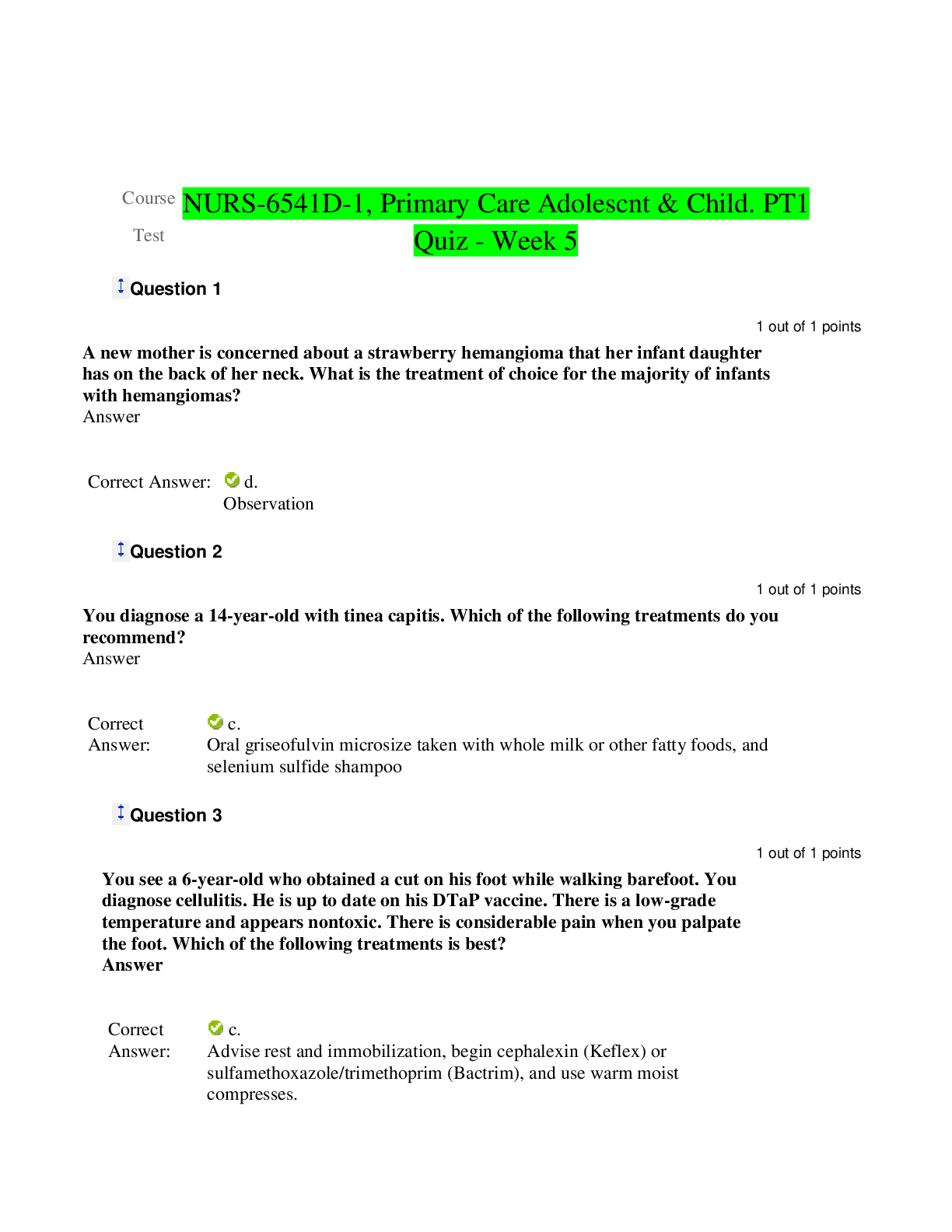


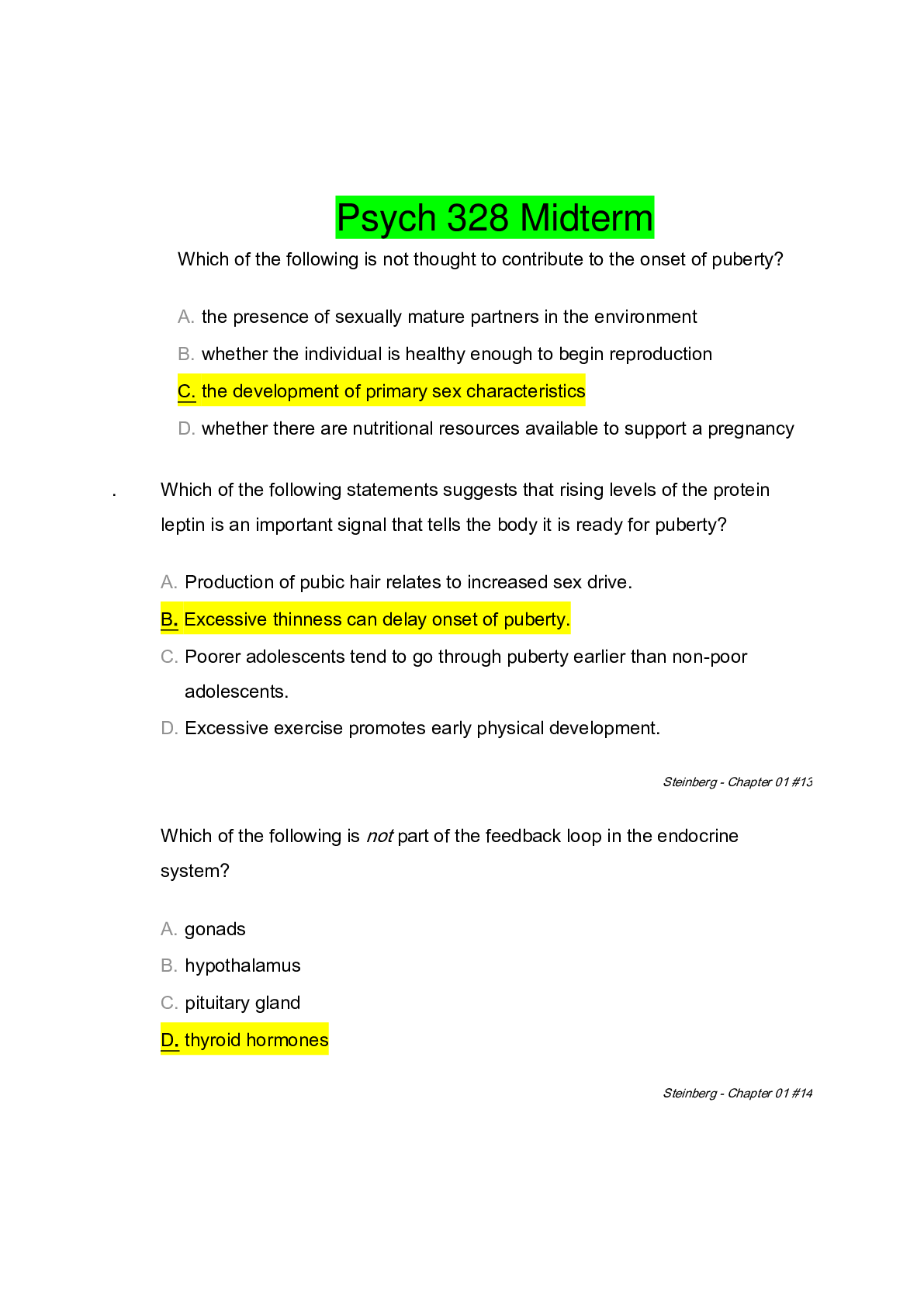

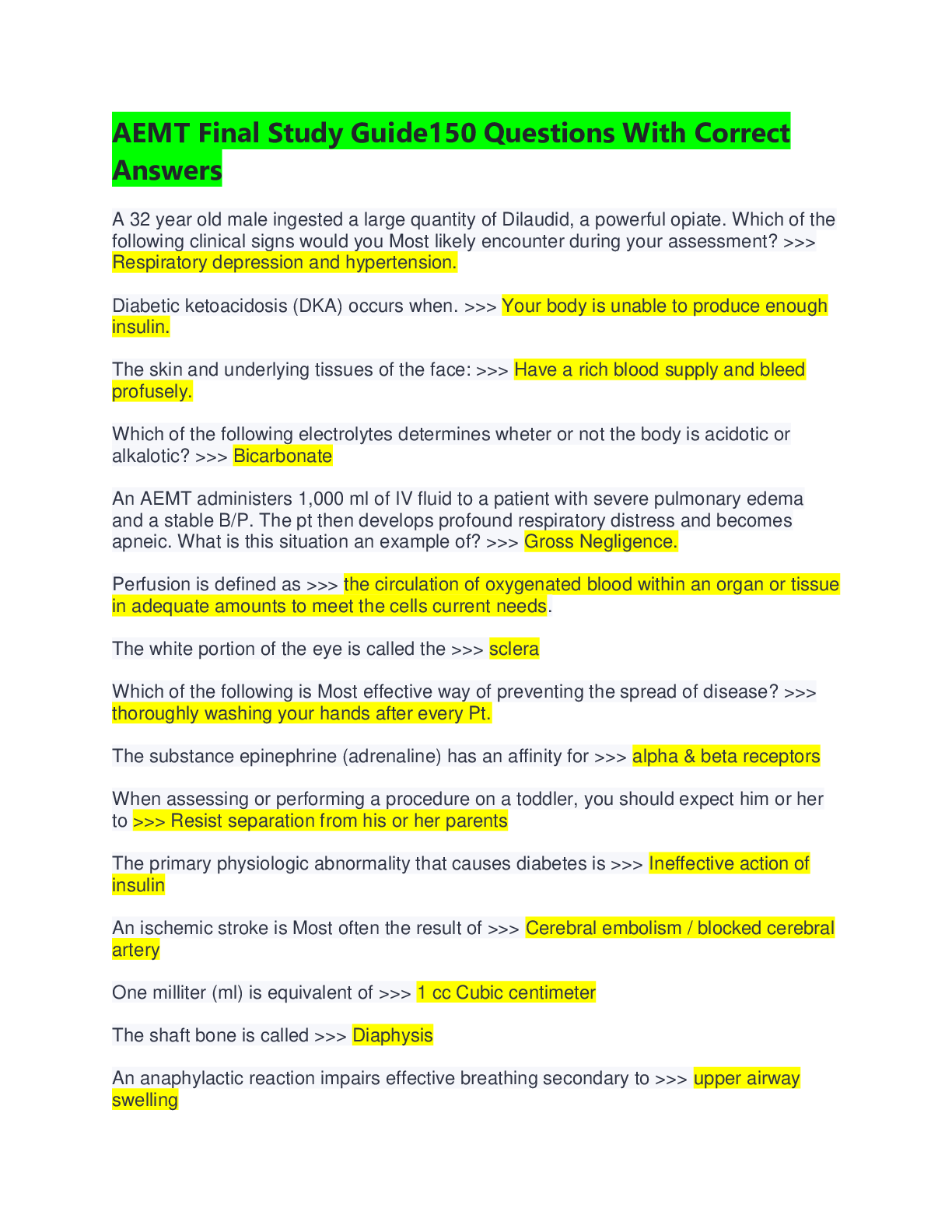
.png)
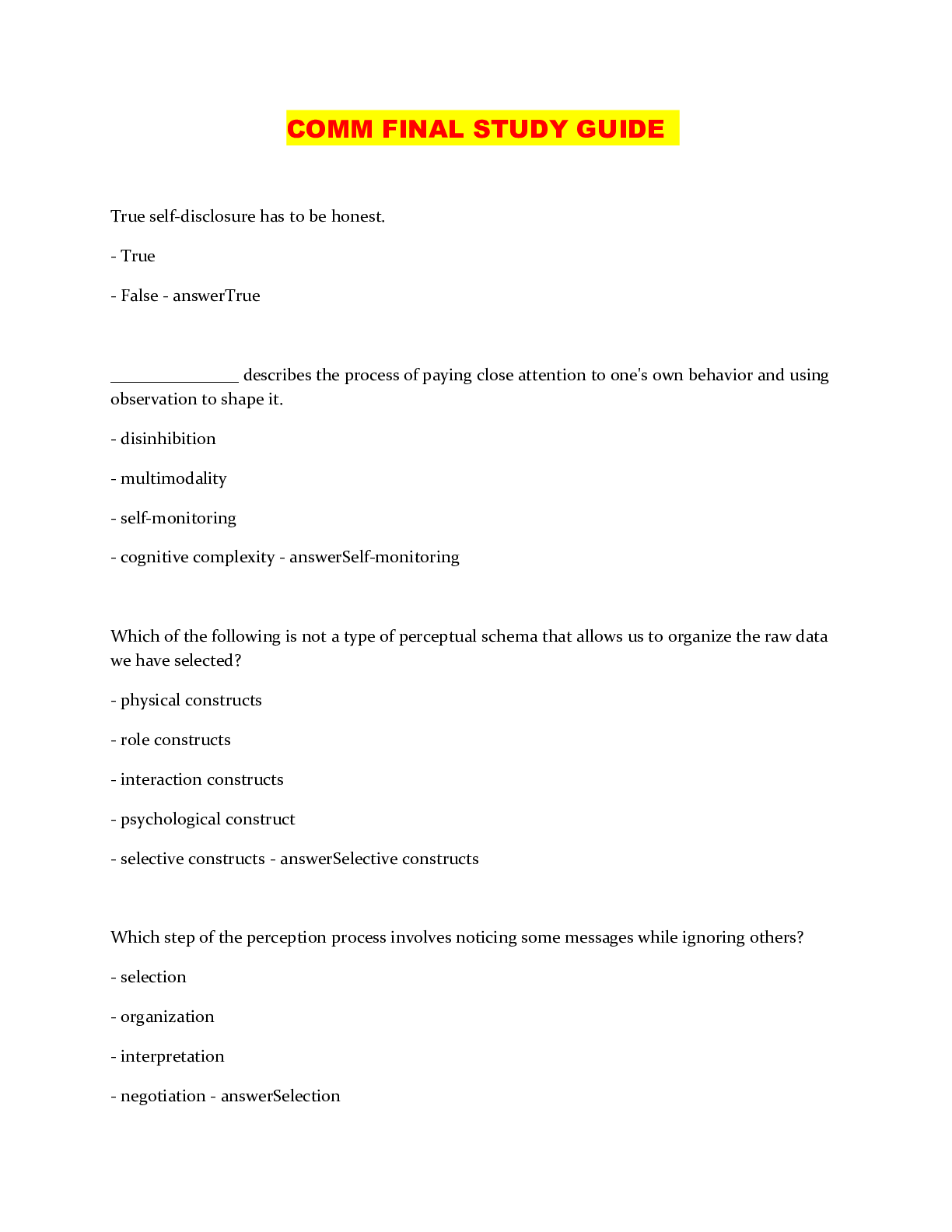
.png)
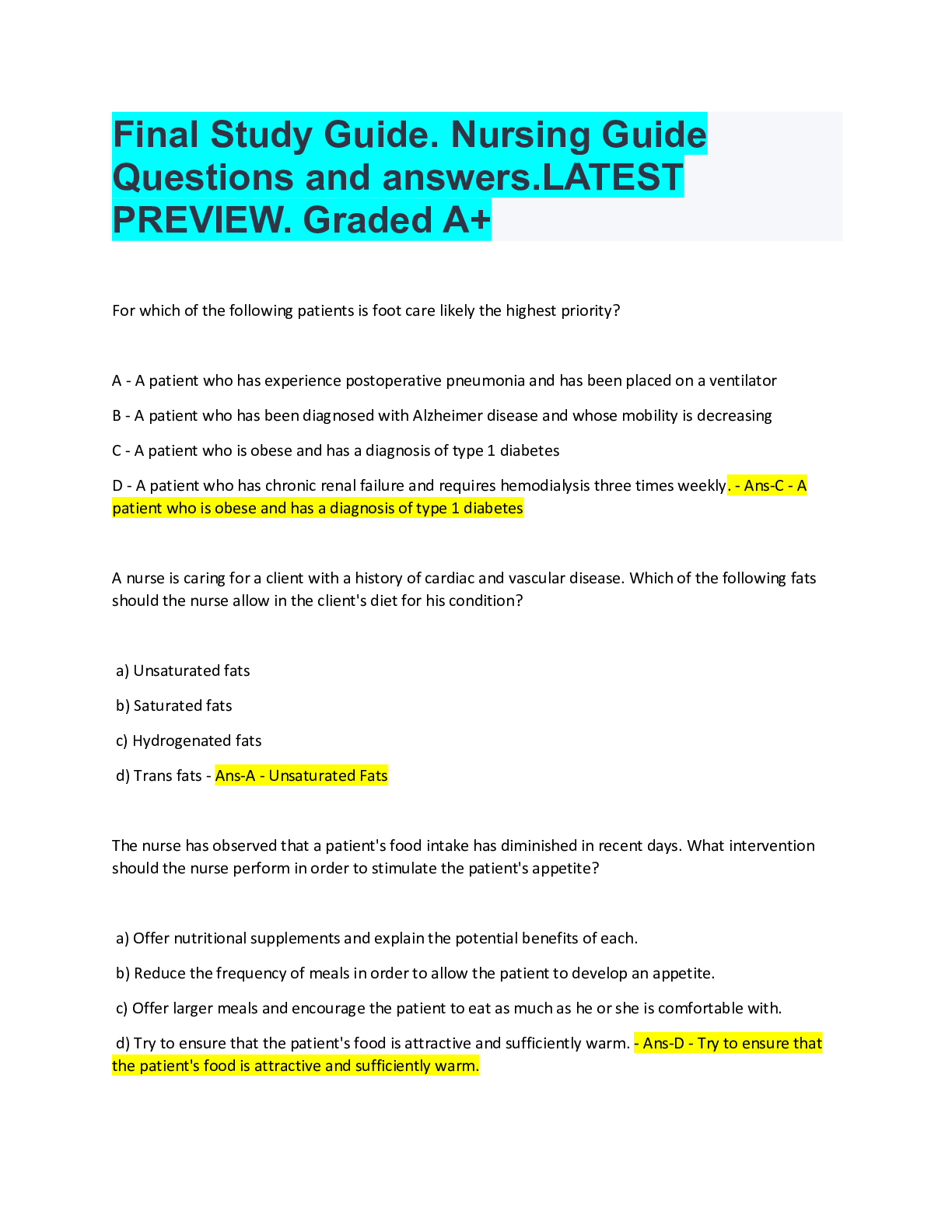
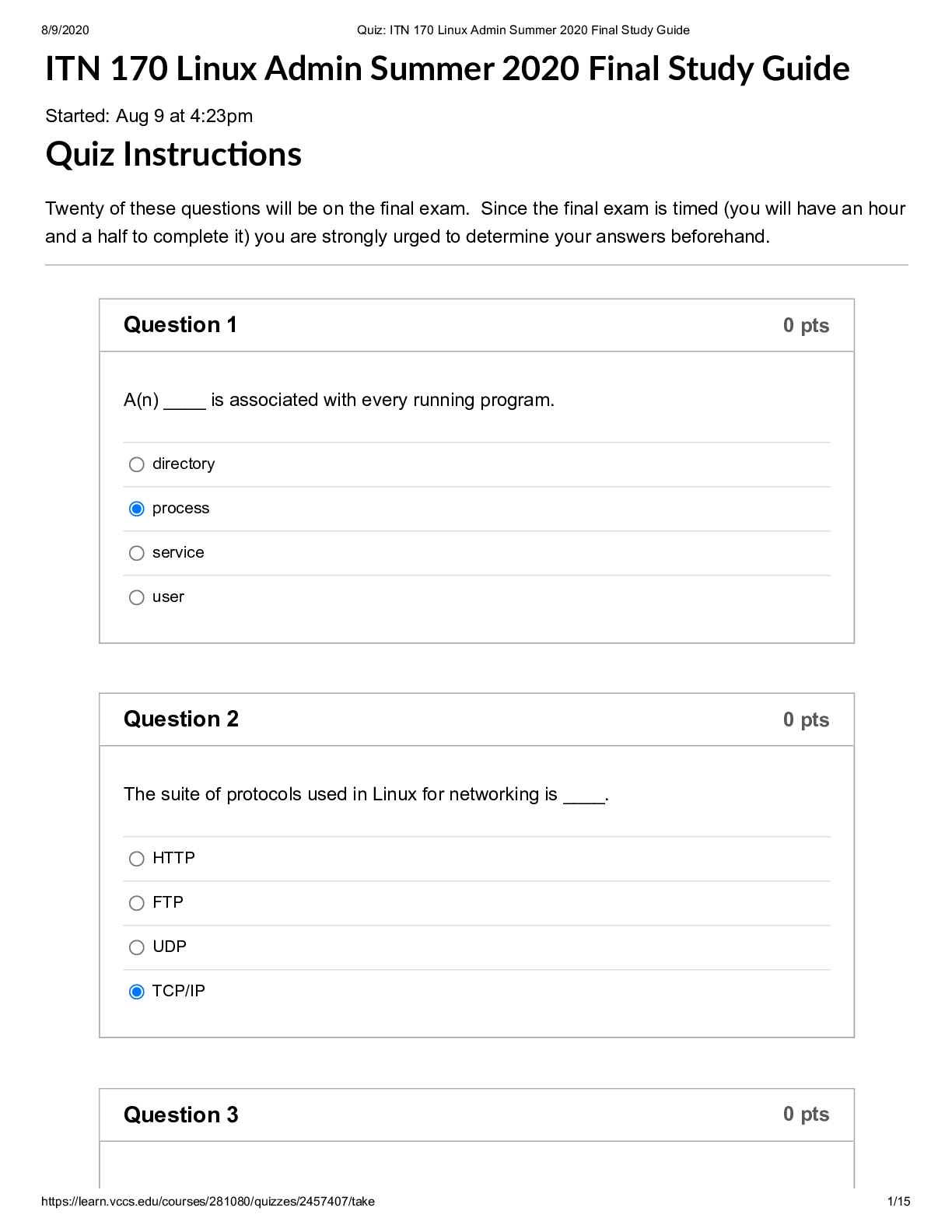

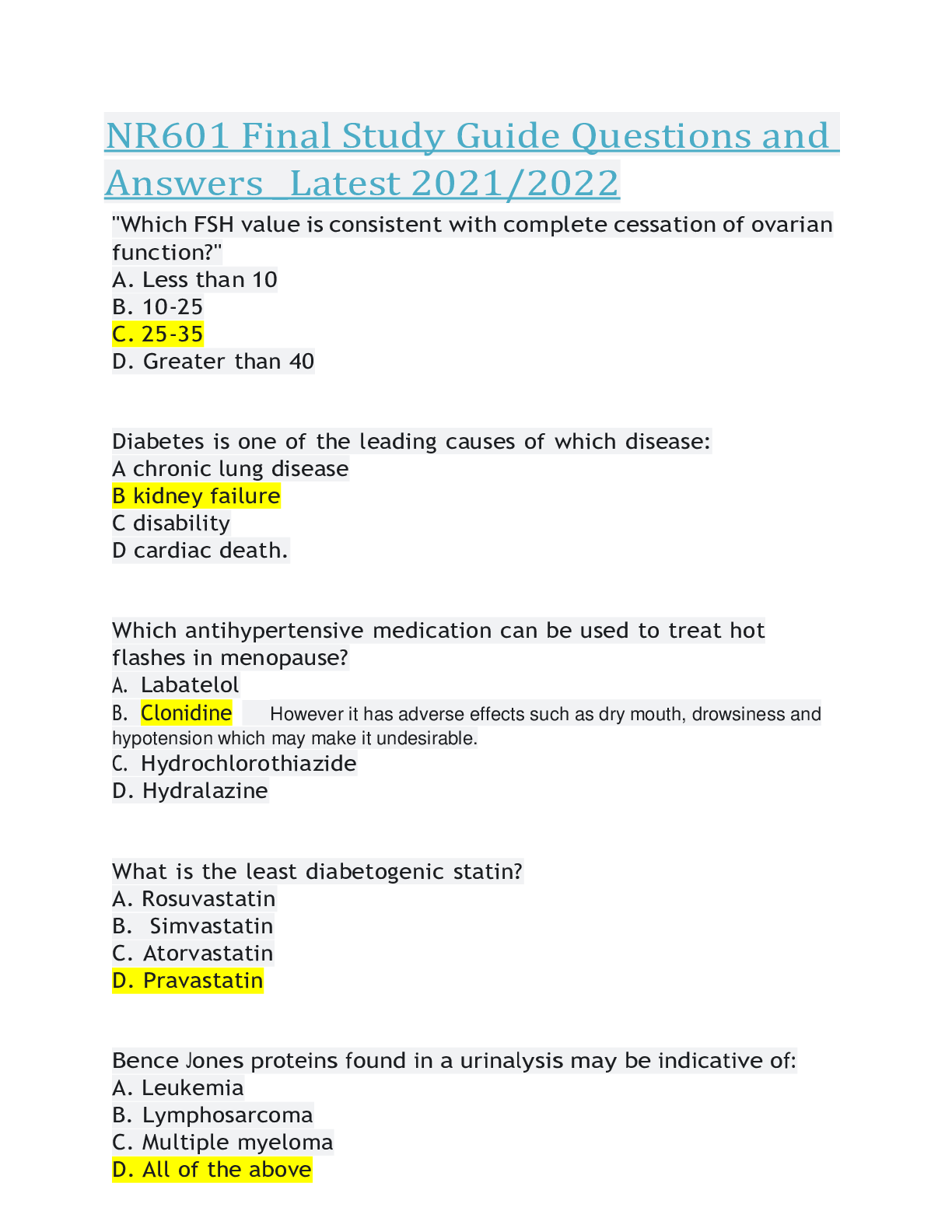
.png)
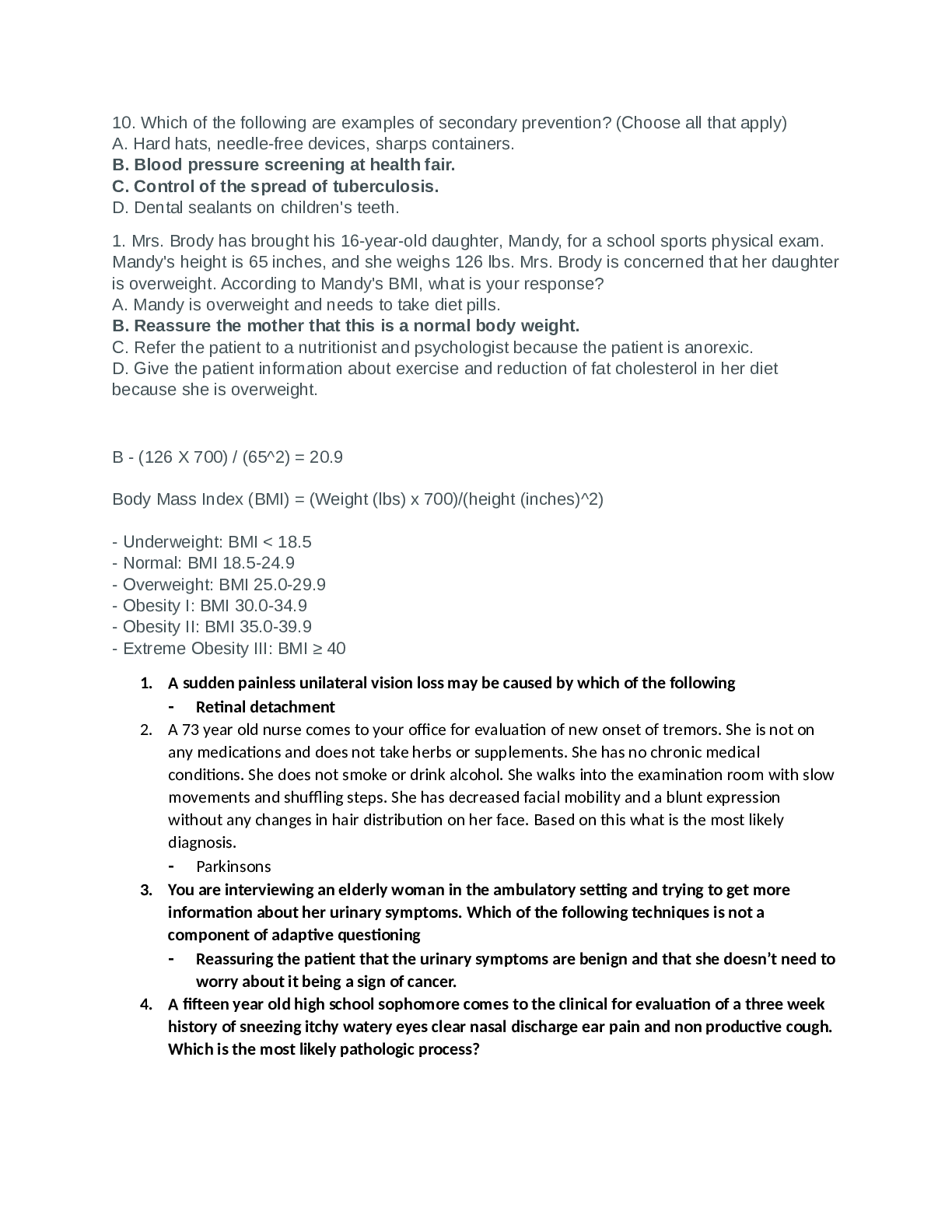
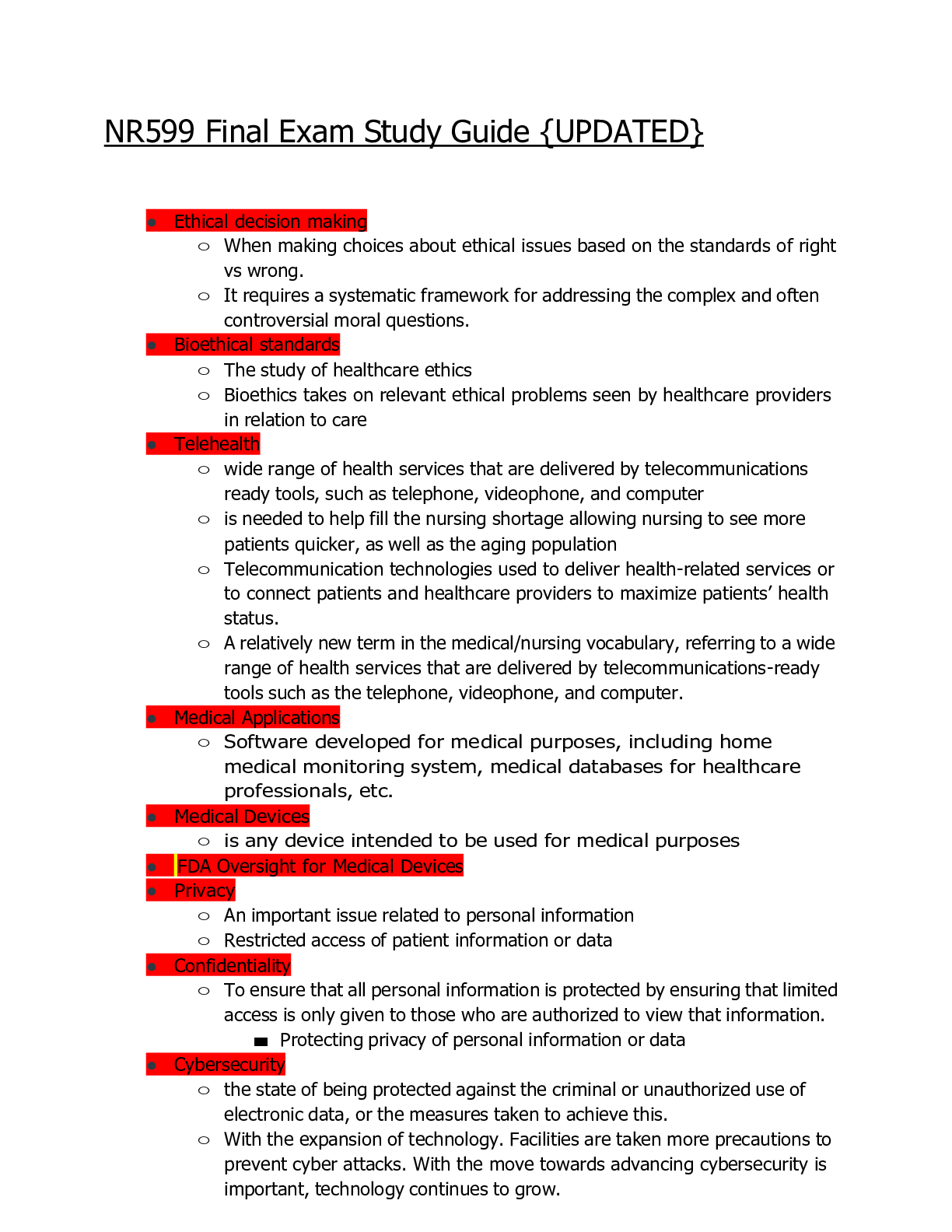
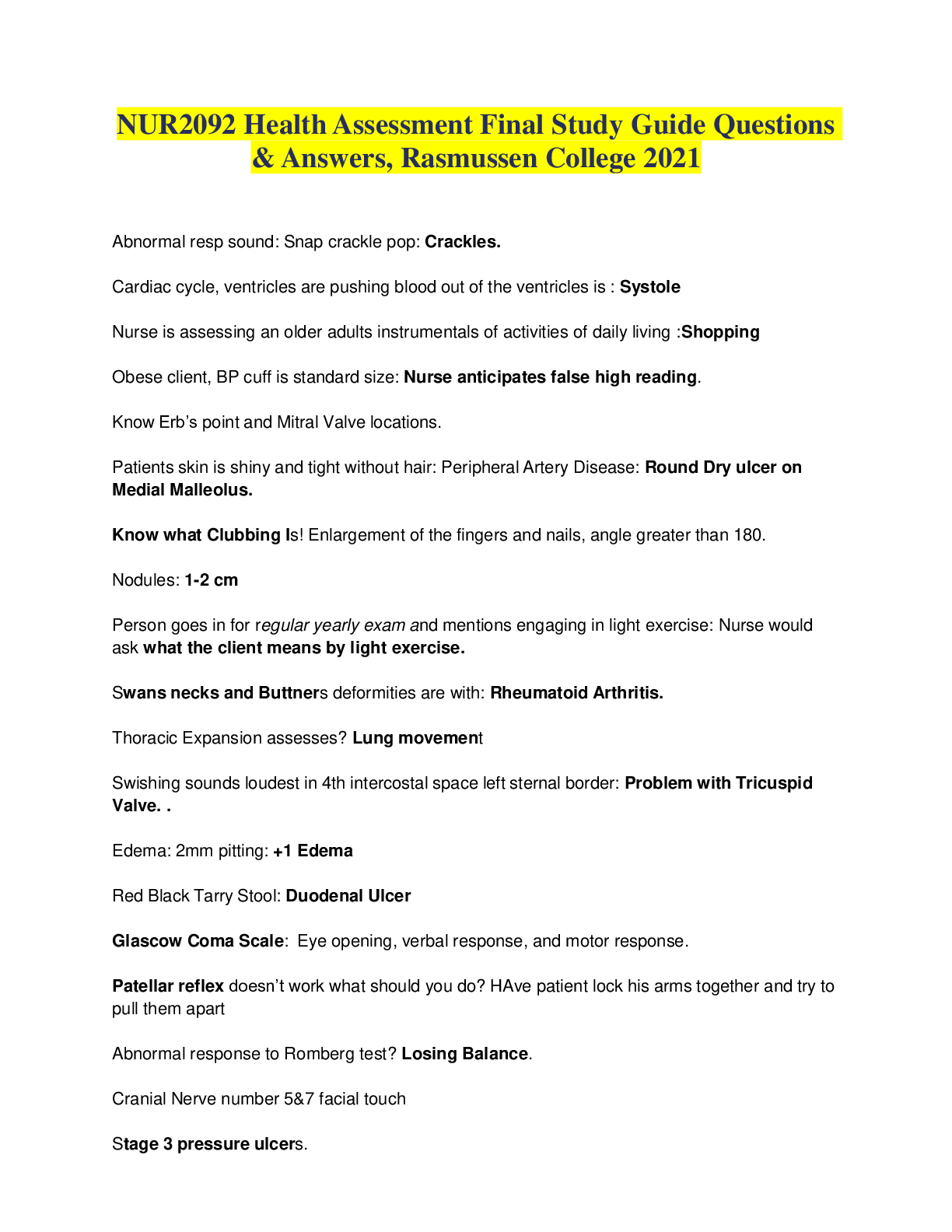

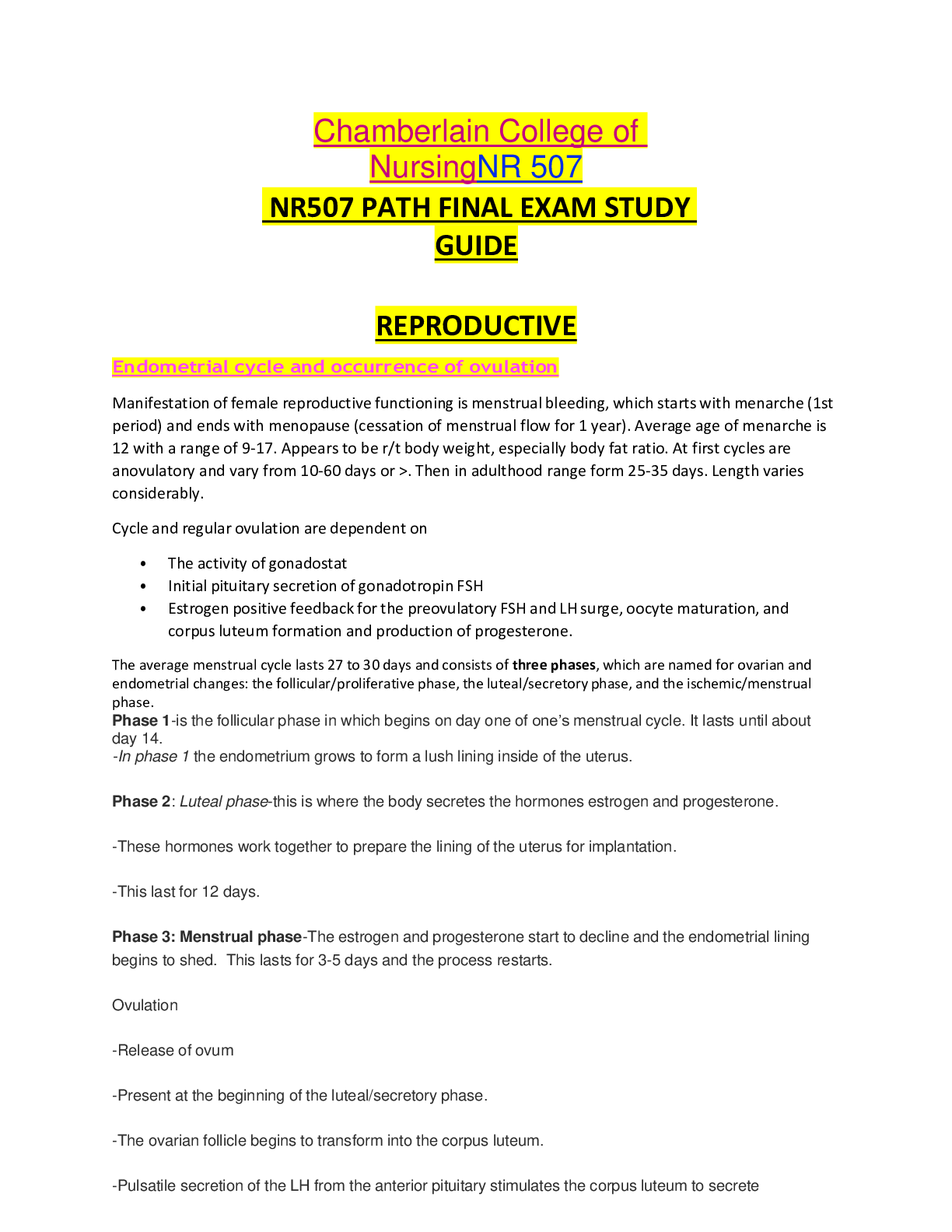
.png)

